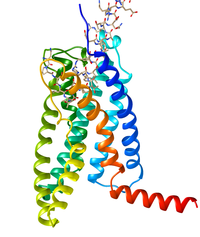
Photo from wikipedia
The ability of many drugs of abuse, including cocaine, to mediate reinforcement and drug-seeking behaviors is in part mediated by the corticotropin-releasing hormone (CRH) system, in which CRH exerts its… Click to show full abstract
The ability of many drugs of abuse, including cocaine, to mediate reinforcement and drug-seeking behaviors is in part mediated by the corticotropin-releasing hormone (CRH) system, in which CRH exerts its effects partly via the CRH receptor subtype 1 (CRHR1) in extra-hypothalamic areas. In fact, CRHR1 expressed in regions of the mesolimbic dopamine (DA) system have been demonstrated to modify cocaine-induced DA release and alter cocaine-mediated behaviors. Here we examined the role of neuronal selectivity of CRHR1 within the mesolimbic system on cocaine-induced behaviors. First we used a transgenic mouse line expressing GFP under the control of the Crhr1 promoter for double fluorescence immunohistochemistry to demonstrate the cellular location of CRHR1 in both dopaminergic and D1 dopaminoceptive neurons. We then studied cocaine sensitization, self-administration, and reinstatement in inducible CRHR1 knockouts using the CreERT2/loxP in either dopamine transporter (DAT)-containing neurons (DAT-Crhr1) or dopamine receptor 1 (D1)-containing neurons (D1-Crhr1). For sensitization testing, mice received five daily injections of cocaine (15 mg/kg IP). For self-administration, mice received eight daily 2 h cocaine (0.5 mg/kg per infusion) self-administration sessions followed by extinction and reinstatement testing. There were no differences in the acute or sensitized locomotor response to cocaine in DAT-Crhr1 or D1-Crhr1 mice and their respective controls. Furthermore, both DAT-Crhr1 and D1-Crhr1 mice reliably self-administered cocaine at the level of controls. However, DAT-Crhr1 mice demonstrated a significant increase in cue-induced reinstatement relative to controls, whereas D1-Crhr1 mice demonstrated a significant decrease in cue-induced reinstatement relative to controls. These data demonstrate the involvement of CRHR1 in cue-induced reinstatement following cocaine self-administration, and implicate a bi-directional role of CRHR1 for cocaine craving.
Journal Title: Frontiers in Behavioral Neuroscience
Year Published: 2017
Link to full text (if available)
Share on Social Media: Sign Up to like & get
recommendations!